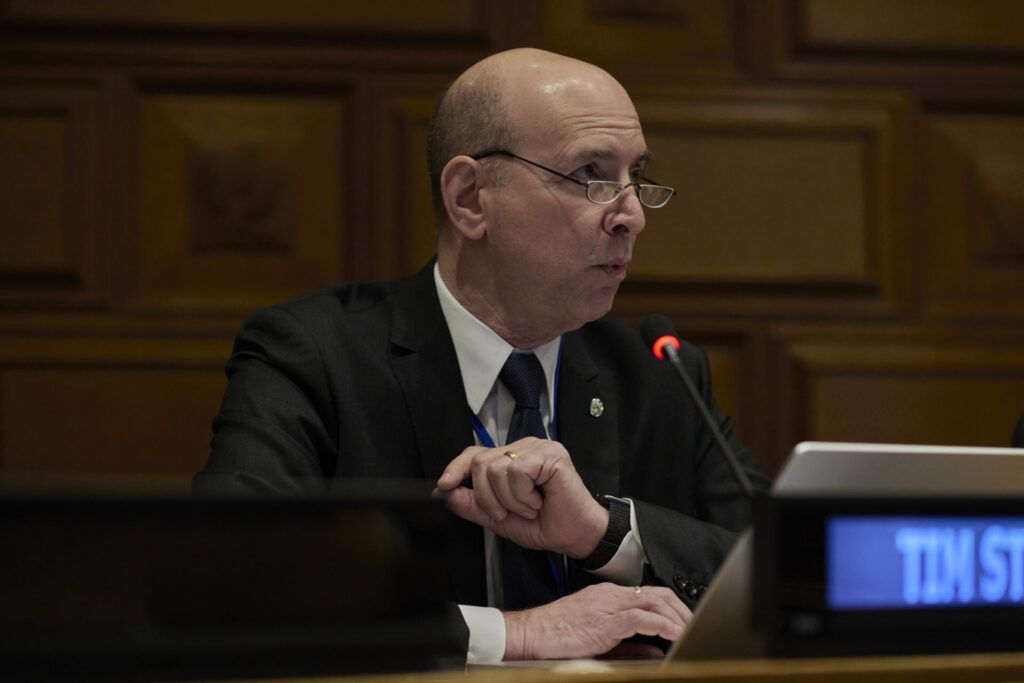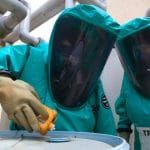Tim Stearns remarks at the Pathogens Project report launch
By Tim Stearns | March 8, 2024
 Tim Stearns speaks at the 2024 Pathogens Project report launch at the United Nations Headquarters. Photography credit: Darren Ornitz
Tim Stearns speaks at the 2024 Pathogens Project report launch at the United Nations Headquarters. Photography credit: Darren Ornitz
Below is a transcript of Tim Stearns remarks at the Bulletin‘s 2024 Pathogens Project report launch at the United Nations Headquarters.Tim Stearns is the Dean and Vice President of Education at The Rockefeller University, where he is also Professor and Head of the Laboratory of Cellular Dynamics. Stearns’s research is on the structure and function of cells and the evolution of cellular traits. He is the recipient of a Howard Hughes Medical Institute Professor award and has taught extensively nationally and internationally, including in Africa and South America. Stearns also advises the U.S. government on biodefense and biosecurity and has been on the science boards of several national laboratories. He is a member of the JASON advisory group.
Thank you to the UN for hosting this meeting, and to the Bulletin of the Atomic Scientists for engaging with this important problem.
I am a professor and the dean of the graduate school at The Rockefeller University, which is just 20 blocks uptown from where we are talking today. I have also advised the US gov’t on matters of biosecurity for more than 20 years as a member of JASON, an independent group of academic scientists with broad expertise relevant to national security.
I am here to provide a viewpoint from academia, specifically academic biomedical research. In my own research I am a cell biologist and geneticist, studying how the cells of our body grow, divide and signal to each other, both in health and disease. I, and most colleagues in biomedical research, are engaged in what is ultimately fundamental research, intended for open publication, into the causes of human disease, the specific mechanisms by which disease occurs, and possible therapies to treat such disease.
Research on infectious disease, that caused by viruses, and bacterial and fungal pathogens, is a tremendously important part of the portfolio of global biomedical research. This research is the means by which we identify the causal agents of infectious disease, understand how they work, and devise strategies to prevent infection or mitigate its effect.
As I noted, I come to you from Rockefeller University. Rockefeller was founded in 1901, originally as the Rockefeller Institute, the first biomedical research institute in the US. It was founded by John D Rockefeller, specifically to address infectious disease at a time when tuberculosis, diphtheria, and typhoid fever were considered the greatest threats to human health.
I will provide an example from a Rockefeller scientist to illustrate the importance of research on viral pathogens. Charles Rice is a professor at Rockefeller and won the Nobel Prize in 2020, along with Harvey Alter and Michael Houghton, for their work identifying the hepatitis C virus as the cause of one from of hepatitis, a serious liver disease. The virus had been identified, but no one had been able to do the critical experiment – showing that it could cause hepatitis directly – because it hadn’t been possible to culture the virus. Rice used genetic engineering to make a complete version of the hepatitis C virus genome and showed that this alone was sufficient to cause hepatitis. Based on this work we now have anti-viral treatments that can cure more than 95% of people with the infection. Similar types of work, played out over much shorter time frames, were critical to our response to COVID-19 and the SARS-CoV2 virus, which I won’t belabor as they are now familiar.
But we are here to discuss biosafety and biosecurity because the very tools that enable the discoveries of virologists studying important human pathogens also create potential risk. Some of these tools are the stock in trade of classical virology – for example, collecting and culturing viruses from nature and assessing their properties.
Others are tools that we have had access to for some time, but that are accelerated by the constant advance of biotechnology. For example, the ability to engineer DNA in the lab – change the sequence of the DNA – and to determine the consequences of that change. This is facilitated by improved methods of cloning, greater access to synthetic DNA, mostly from commercial sources, and development of systems for converting that DNA into active virus. As with most developments in biotechnology these start out as capabilities requiring substantial expertise and therefore having limited access, but soon become democratized and widely used across the global biology research enterprise.
Importantly, there are now tools that we are only beginning to understand how they will be used in biological research. For example, the astonishingly rapid rise in the capabilities of artificial intelligence and machine learning – particularly the large language model form of AI – have caught most biologists by surprise and we are all trying to understand how they can be used to further research, but also how they might be misused.
The risk of application of these tools resulting in the creation of, or accidental or intentional release of, an agent that could cause widespread disease or many deaths is relatively low, but it is real and should be acknowledged. I say that it is low because we know rather little about how properties such as virulence and transmissibility are determined by genetic sequence, and most manipulations in the lab result in viruses that function less well – in molecular biology as in much of life, it is much easier to break something than to make it work “better,” if you will.
But we know that the risk is real because there have historically been accidental releases from research labs that have resulted in infection and death of individuals. There has also been intentional release of biological agents that have resulted in deaths and mass disruption, for example the Amerithrax case in the US in 2001 involving the release of Bacillus anthracis spores.
Also, many biologists are aware that the US and the Soviet Union, among others, had substantial biological weapons programs in the 20th century, with purposeful research into making pathogens more virulent and transmissible. These programs were addressed by the Biological Weapons Convention of 1975, but there remains great concern that the ease of creation and production of such agents will cause others to seek them as a means of achieving desired ends.
Scientists working on viruses understand the potential risks to the individual researcher of working with dangerous pathogens and have created a range of systems to reduce the need to work with active viruses. These have broadened access to pathogen research, as most of these systems do not yield infectious particles capable of replication and can be safely used outside of the high-level containment facilities required for some viral pathogens.
Ideally, this understanding of risk would go beyond that to the individual researcher and extend to an understanding of risk to the broader population and to society. The report released today is from the Bulletin of the Atomic Scientists, a group created after World War II, the development of atomic bombs by the US and the ensuing nuclear arms race. All physicists are aware of the history of the involvement of physicists in the creation of the bomb – indeed, this is the basis of one of this year’s most popular Hollywood movies – and the disciplines of physics and applied physics are still associated with technological developments related to defense. Many PhD students in those disciplines will go on to work in national laboratories on these technologies.
It is important to understand that biologists do not have such a story to tell. Certainly, there were biologists who were part of the research in the weapons programs, but that has not been publicized and most academic biologists are not fully aware of these programs. In teaching our graduate students and postdoctoral fellows we focus almost exclusively on the very real good that comes from biology research. We should consider it an obligation to teach about the risks, including cases from the past to make clear that the risk is real.
Lastly, I want to highlight that science is an international endeavor. Pasteur said “Science knows no country, because knowledge belongs to humanity, and is the torch which illuminates the world.” At graduate schools in the US we train students from all over the world, and we expect that they will go on to do great things, either here or elsewhere. Infectious disease also knows no country, and scientific collaboration between academic researchers in different countries is essential to progress.
At the same time, it is clear that science and technology are the keys to economic security and national security. This is particularly true now as we come to appreciate the ways that the changing environment and how we respond to it are critical factors in security. That leads to competition and the perception that holding data private provides advantage. Trust between international partners is critical sharing. I am reminded of the Open Skies treaty which was in effect for 20 years, that allowed one participating country to conduct short-notice, unarmed reconnaissance flights over another participating country, with few restrictions on the territory covered. Russia and the US were the main nations in this treaty and conducted many such flights over each other’s territory before the agreement was terminated.
I hope that this report, and the engagement of the UN, can help to mitigate that very real risk that comes from a breakdown of trust and the failure to meaningfully collaborate on this critical problem.
To watch the full 2024 Pathogens Project livestream, click here.
Together, we make the world safer.
The Bulletin elevates expert voices above the noise. But as an independent nonprofit organization, our operations depend on the support of readers like you. Help us continue to deliver quality journalism that holds leaders accountable. Your support of our work at any level is important. In return, we promise our coverage will be understandable, influential, vigilant, solution-oriented, and fair-minded. Together we can make a difference.
Keywords: pathogens project
Topics: Uncategorized














